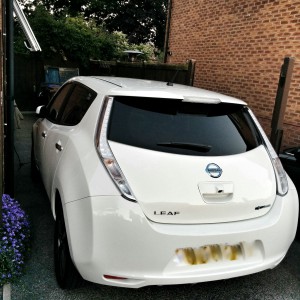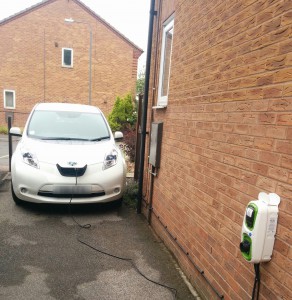December 11, 2015, by sustainablenottingham
Turning over a new leaf
Liam Jones, who works in the University’s Grounds team, shares his experience of buying an electric car.
We had always hoped to own an electric vehicle (EV) for the cost and environmental benefits, and this June my partner and I traded in our Fiat Brava 1.6 Eco Diesel for an all-electric Nissan Leaf Tekna.
The increasing cost of diesel began to creep into other areas of our budget. So earlier this year we began looking at electric cars. Initially, we planned to look at a Renault Zoe but decided it was too small for our needs. After test driving a Nissan Leaf, we were blown away with drive experience. Electric vehicles are more expensive than standard cars, so we doubted whether it would fall into our modest budget. With approximately £9,000 in government grants and dealer contributions, we were pleased to get the car comfortably in the budget.
After taking delivery of the car we had a charging point installed on our driveway, for this we received another £750 in grants, making the total cost to us £190. Part of that installation is an energy meter separate from property’s. This makes tracking your expenditure simple. We are currently operating at 3.9p per mile, however, this as been as low as 1.8p when we have used free charging points at service stations nationwide, and many retail outlets like IKEA. The total running cost is about 20% of the eco diesel our EV replaced. With the finance payment and electricity coming in at less than the monthly diesel cost.
I don’t think I could return to a standard car after owning an EV, but that’s not to say there aren’t caveats. Most obvious is the approximate 100-mile range, which will not suit everyone’s driving needs. Luckily we tend to travel longer distances by train. For other times, Nissan offers 2 weeks of free car rental per year. Although our only car, I could see it being a suitable second car for many people. Secondly, the environmental cost is still present. We are hoping to get solar panels installed in 2016, this will primarily be used to power the car, with any excess being stored for use in the property.
No comments yet, fill out a comment to be the first



Leave a Reply